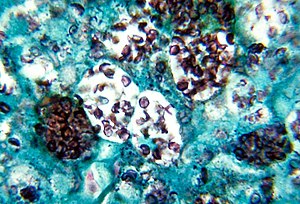Histoplasmosis is a disease caused by the fungus Histoplasma capsulatum.[2] Symptoms of this infection vary greatly, but the disease affects primarily the lungs.[3] Occasionally, other organs are affected; called disseminated histoplasmosis, it can be fatal if left untreated.
Histoplasmosis is common among AIDS patients because of their suppressed immunity.[4] In immunocompetent individuals, past infection results in partial protection against ill effects if reinfected.
Histoplasma capsulatum is found in soil, often associated with decaying bat guano or bird droppings. Disruption of soil from excavation or construction can release infectious elements that are inhaled and settle into the lung.
From 1938 to 2013 in the US, 105 outbreaks were reported in 26 states and Puerto Rico. In 1978-1979 during a large urban outbreak in which 100,000 people were exposed to the fungus in Indianapolis,[5] victims had pericarditis, rheumatological syndromes, esophageal and vocal cord ulcers, parotitis, adrenal insufficiency, uveitis, fibrosing mediastinitis, interstitial nephritis, intestinal lymphangiectasia, and epididymitis. Histoplasmosis mimics colds, pneumonia, and the flu, and can be shed by bats in their feces.
| Histoplasmosis | |
|---|---|
| Other names | Cave disease,[1] Darling's disease,[1] Ohio valley disease,[1] Reticuloendotheliosis,[1]Spelunker's lung and Caver's disease |
 | |
| Histoplasma capsulatum. Methenamine silver stainshowing histopathologic changes in histoplasmosis | |
| Specialty | Infectious disease |
https://en.wikipedia.org/wiki/Histoplasmosis
Neil J. Korman, in Goldman's Cecil Medicine (Twenty Fourth Edition), 2012
Molluscum Contagiosum
Molluscum contagiosum...Patients infected with human immunodeficiency virus (HIV) may have hundreds of lesions, and some lesions can be larger than 15 mm (Chapter 399).
https://www.sciencedirect.com/topics/medicine-and-dentistry/molluscum-contagiosum
Liposomal amphotericin B was significantly more effective than amphotericin B deoxycholate for the treatment of moderate to severe disseminated histoplasmosis in patients with AIDS, with 88% and 64% of patients, respectively, having a successful response.
https://pubmed.ncbi.nlm.nih.gov/19275278/
In immunosuppressed individuals such as those with HIV infection, disseminated deep fungal infections such as cryptococcosis and histoplasmosis can be indistinguishable clinically from MC.14,15
https://www.sciencedirect.com/topics/neuroscience/molluscum-contagiosum
Above. scorpions - still lovin you
No comments:
Post a Comment